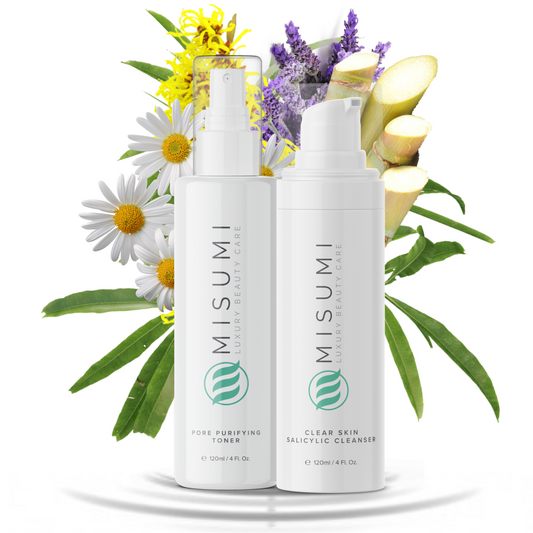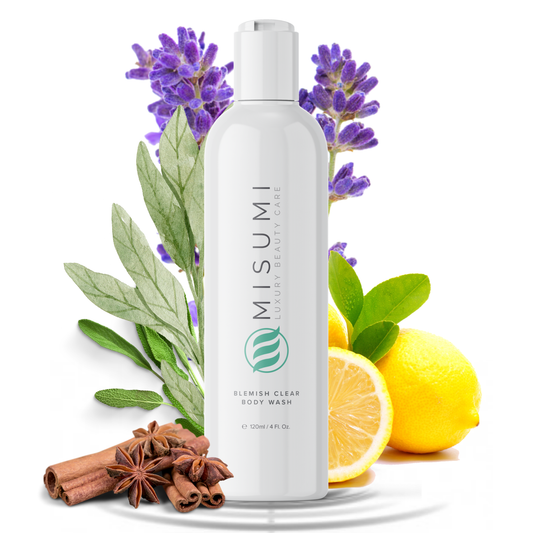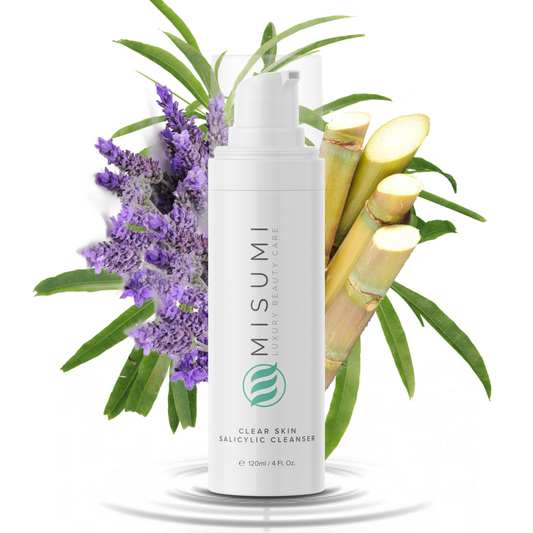You’ve probably come across the term double cleansing in skincare and wondered what it could possibly be referring to. Don’t worry – you’re not the only one. Since it’s quite a new concept in the skincare world, not many people know about it. And what’s even more interesting is that some people employ it to the fullest without even realizing what it is or that they’re even doing it.
Cleansing your skin twice a day is essential, all of us are well aware of that. No matter what your skin type is, you ought to find a face cleanser that will suit your particular skin type and help you get that clear skin all of us desire.
So what is this double cleansing idea and how can it be incorporated in your existing skincare routine? This article will explain what the double cleanse method actually consists of, how to do it, who should do it and whether it’s worth doing at all. If you’ve ever had any questions regarding this method, then you’re in the right place. Let’s start with the basics - which is the question: What Exactly Is Double Cleansing?
Double Cleansing Explained

Double cleansing refers to the method of washing your face two times back-to-back instead of one, using two different cleansers each time. One of the most common ways people practice this method is by firstly using an oil-based cleanser, one which does the majority of the cleaning, and then following it up with a regular cleanser which is either a gel, foam or lotion.
One of the reasons this first option works best is because some makeup can be quite hard to remove from the face, and by using an oil-based cleanser you’ll have a much easier time removing stubborn makeup. By following up with that initial cleanser, you’re ensuring that the oil doesn’t cause you any breakouts or irritation, which is usually a struggle for those who have sensitive skin.
Another way you can practice this method is by using the same cleanser two times in a row, which is the less popular version of the method.
Where It All Started
This technique became popular in Japan and South Korea, where a lot of skincare trends seem to originate. It’s noted as far back as the fourteenth century, where documents show that Korean women used all kinds of plant oils in order to cleanse their skin.

This fact isn’t surprising at all if we were to consider how popular plant oils have been throughout the centuries, both as a cosmetic ingredient and as medicine. This application was followed by a water cleanser, but not like the ones we have now! Korean women would infuse healing plants into their water and wash their faces with the water after it’s been marinating for a couple of hours.
Who Should Double Cleanse
Double cleansing is probably for you if you’re an avid makeup user. And why is that so? Well, makeup and all the products we put as primers such as sunscreen, moisturizer or actual primer can be quite hard to get rid of, and most people can’t do it in one go with the normal cleanser they use. That is why some people prefer to use a heavier cleanser as their first step in order to remove most traces of makeup, and then follow it up with a regular, more natural cleanser which will do the actual cleansing and remove any traces of makeup which might be left behind from the first method.
Do you have oily skin, which is characterized by excess sebum and a lasting shiny appearance? If that’s the case, then you might want to think about doing the double cleansing method. Some cleansers are too gentle on the skin and don’t remove all the excess sebum which you’re dealing with, while others are too harsh on the skin. Double cleansing gives you the in-between version, leaving your skin properly cleansed without stripping away all the oil. Using a lighter cleanser twice ensures that your pores are cleaned inside-out, but, at the same time, doesn’t irritate your face or cause dry patches.
How to Double Cleanse – A Step by Step Tutorial

Now let’s get into the important stuff – how to actually double cleanse your face. As I’ve mentioned before, one of the best ways to do this method is by using an oil cleanse first and then following it up with a foam/gel/lotion cleanser that’s water-based.
Why is this important?
Due to the nature of the ingredients, oil-based cleansers are designed to help you get rid of heavy makeup, any sunscreen or moisturizer you have left or anything that’s been sitting on your skin all day long. That’s one of the reasons you should start this method off by using an oil-based cleanser and gently massage it into your face with circular motions. Add a few drops of water as you go along. Once you notice that your face is makeup-free, rinse it off with warm water.
The next step is following that up with a water-based cleanser. The same rules apply with a water cleanser – just massage it on your skin with gentle, upward motions and then rinse it off.

Аfter you’re done double cleansing, follow your skincare routine steps as you would otherwise. If you apply a serum on a regular basis, any toners or vitamins, then they should follow right after the cleansing. Whichever one of these you choose to include in your routine (or even all of them!) will depend largely on the type of skin you have and which problem areas you want to target. It’s a common misconception that people who have oily skin shouldn’t moisturize their face because it could somehow add to the already existing sebum overproduction.
However, this myth could not be further from the truth! People who have oily skin should moisturize their face just like someone who has dry skin. Moisturizing on a regular basis can actually be beneficial for you if you struggle with sebum overproduction. That being said, save the moisturizer for last. It should be the last face product you apply on your face. If you’re on the lookout for a great moisturizer that will help you get rid of any premature signs of aging and keep your skin youthful and glowy in the long run, make sure you check out our best-selling wrinkle-free moisturizer.
Under-eye creams are also a part of a proper skincare routine. The area under your eyes is very gentle and prone to over-drying, so make sure you include a good quality moisturizing under eye cream that can effectively battle the dryness in that area.
Which Cleansers to Use?

There are so many cleansers to choose from, it’s natural to get overwhelmed by the enormous selection of products out there! But don’t worry, this article is here to help!
There are a few basic rules you should follow when picking out a cleanser, and most of them have to do with the skin type you have.
If your skin is oily, then you’ll need something slightly more cleansing than those who have dry skin, but a product that’s not too abrasive on the skin. For this reason, staying within the realm of gel or foam facial washes is crucial. Try to include ingredients such as glycolic acid, clay, hyaluronic acid, and retinols, since these tend to control sebum production and clean your pores without stripping your skin from all the much-needed natural oils.
If you have combination skin, you can get away with using both milder cleansers and gel/foam ones.
If you have dry skin, look for cleansers that have a softer and milkier texture, one that reminds you of lotions. These will be milder on the skin and help with the hydration aspect, which is a common struggle.

For those of you who struggle with sensitive skin, one thing to keep in mind is not just the texture of the cleanser you’re planning on using, but also the ingredients it contains. We talked about which products people with oily skin should include in their skincare routine, but now it’s crucial to mention the ingredients those with sensitive skin should stay away from.
Generally speaking, here are a few ingredients you should not include: artificial colors, perfume, phthalates, lead, mica, formaldehyde, Sodium Lauryl Sulfate (SLS) and Sodium Laureth Sulfate (SLES). The basic rule of thumb is – the simpler and shorter the list of ingredients, the better!
How Often Should I Double Cleanse?
Since we covered the basics of double cleansing, you must be wondering how many times a day it’s advisable to do it.

For most people, in order to see the best results, it’s best to double cleanse only at night. In the evening, after a long day wearing makeup, being exposed to all kinds of dust, bacteria, and pollutants, and layers of products is the best time to do a double cleanse. Doing an elaborate cleansing routine in the evening will ensure that the products you use after you’re done washing your face penetrate as deeply in the skin as possible, making them easier to absorb and therefore more effective and potent.
Most people don’t need to do it in the morning since we’ve just woken out of bed, and, assuming we’ve done our evening skincare routine properly and thoroughly, our skin won’t be dirty or in need of deep cleansing. If you don’t feel the need to do a double cleanse in the morning, just like most people, go ahead and wash your face once with a cleanser of your choice. After you’re done washing and moisturizing your face, it will be prepared for sunscreen, makeup and any other products you’d like to layer on top.
If you feel the need to double cleanse in the morning as well, feel free to try it out for yourself and see how your skin reacts to it. It’s important to remember that cleansing shouldn’t be overdone, and if you do it too frequently, you risk causing certain damage to your skin, which leads me onto the next point.
Can I Over-wash my Face?
The simple answer to this important question is that yes, sometimes you can over wash your face and cause more problems than there were in the first place. Always be sensible not just about how many times you wash your face in a day, but also about the products that you use while you’re doing it.
As you might have noticed by now during your skincare journey, not all products are created equal. Some are harsher than others and contain more chemicals than necessary, making your skin more prone to drying out and becoming irritated due to the number of ingredients you’re introducing it to. Especially pay close attention to whether your cleanser is sulfate-free or not. That way, all the natural moisture that’s designed to lubricate your skin without making it too oily can stay on top of your skin.

If you’re convinced that you’ve overdone the double cleansing method, don’t throw in the towel just yet. Firstly, you need to make sure that both of the cleansers you’re using are compatible with each other, meaning that they don’t contain any weird ingredients that might cause a cross-reaction and make your skin red or irritated. This could leave you thinking that you’re over-washing your face, when, in fact, you’re just using the wrong products.
Another way your products can be incompatible with each other is if they’re both either oil-based or water-based. Remember, if you want to achieve the best results using this method, you will need to use an oil-based cleanser as your first step in order to remove the makeup, sunscreen or other products on your skin, and then follow it up with a water-based cleanser that will erase any traces of makeup or dirt from your skin. Always check the ingredients to make sure that you’re using products with the correct ingredients.
Final Thoughts
Skincare trends come and go, but deep skin cleansing is a staple in every person’s skincare routine. And although everyone’s skin is different, one universal rule applies – you have to try something before you decide it’s not for you.
Hopefully, this article has encouraged you to try out the double cleanse method. If you follow the steps explained above, there are very few things that could go wrong. It’s not like it’s a harsh acid or an exotic ingredient that could leave your skin screaming for help.
That being said, it’s best to talk to a qualified professional if you’re thinking about making substantial changes in your skincare routine. This is the best way to ensure that you’re not making any mistakes and that you’re using all the products in the right order.
This information is meant to supplement, not replace advice from your doctor or healthcare provider and is not meant to cover all possible uses, precautions, interactions or adverse effects. This information may not fit your specific health circumstances, and its goal is to offer a general view of the subject. In case you are suffering from a severe case of acne, you should consult with a dermatologist or a certified medical professional.








